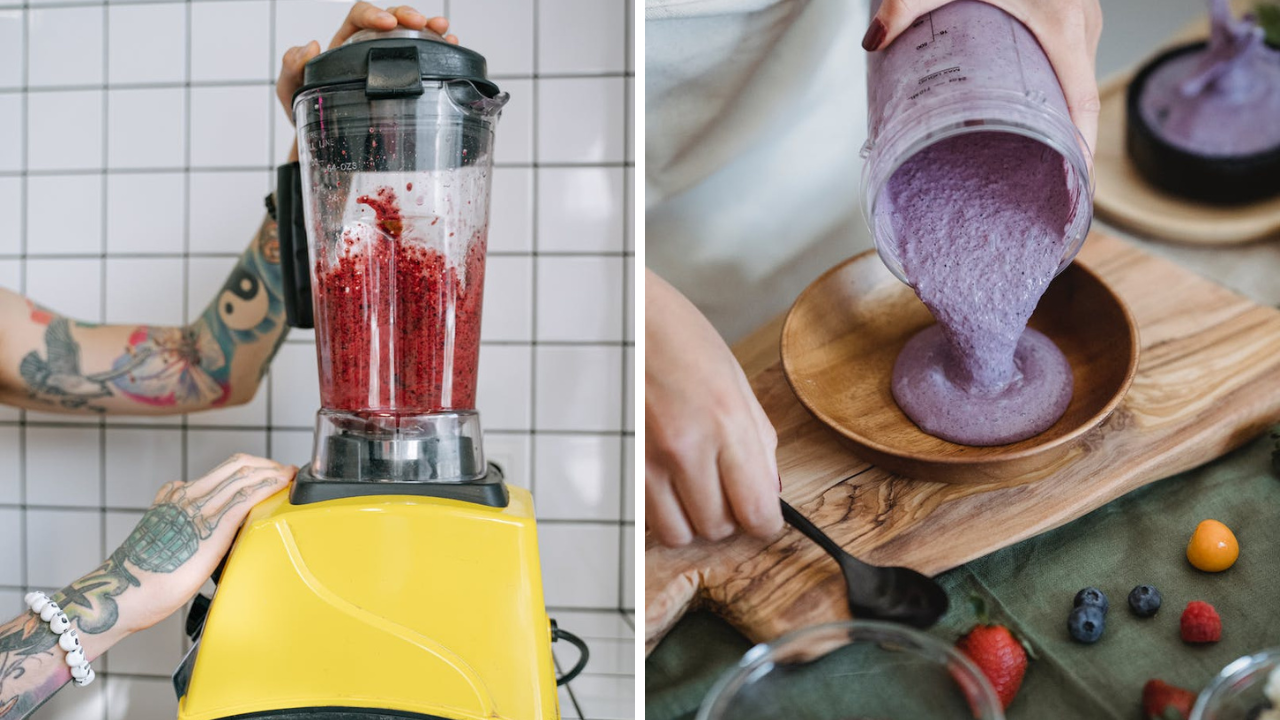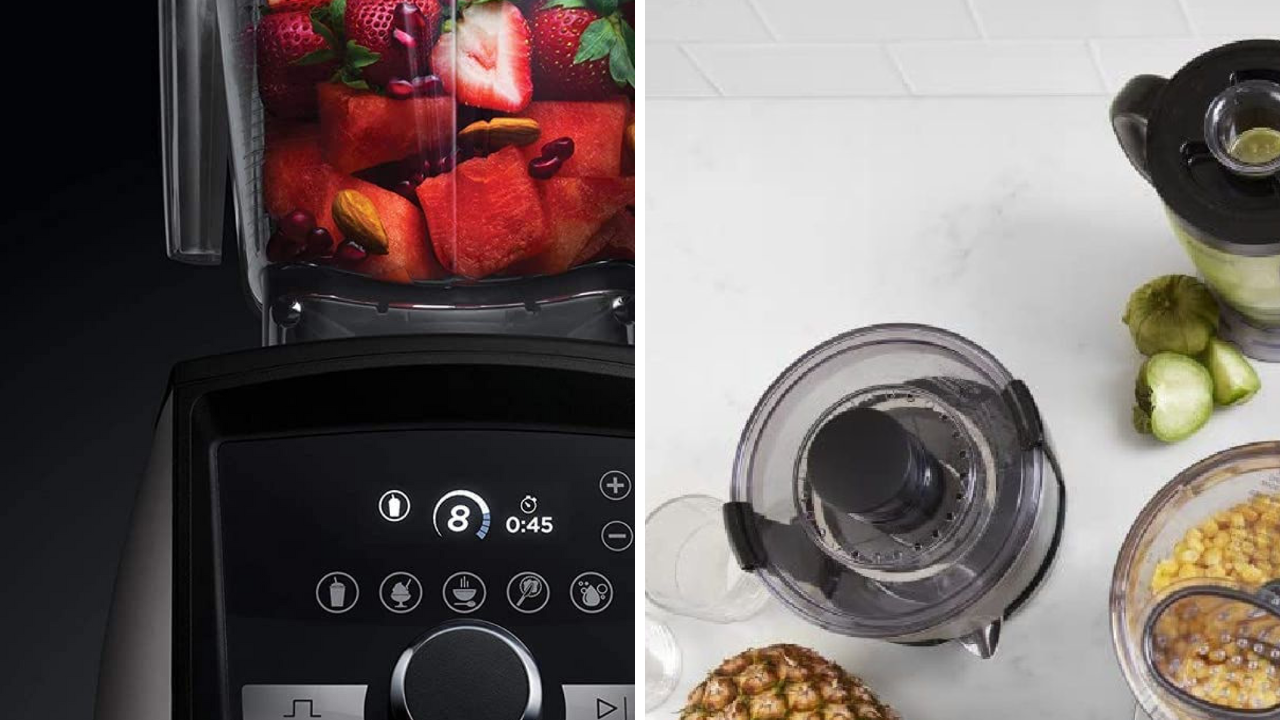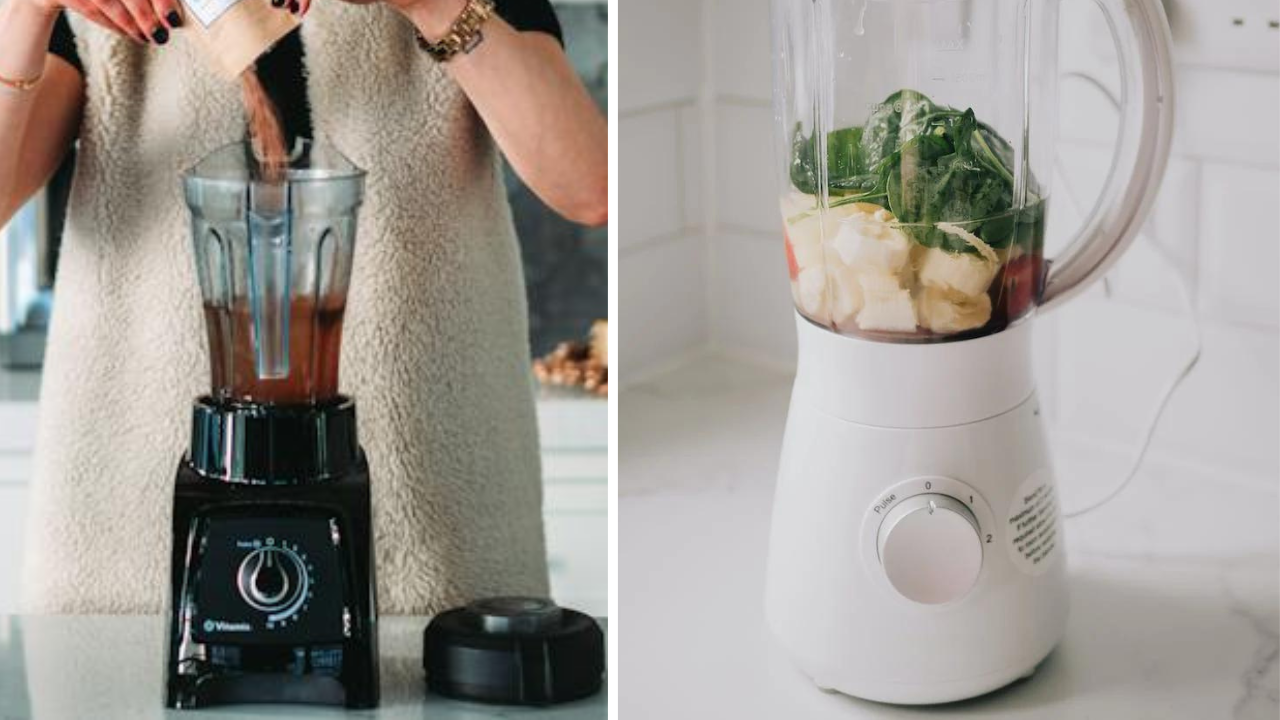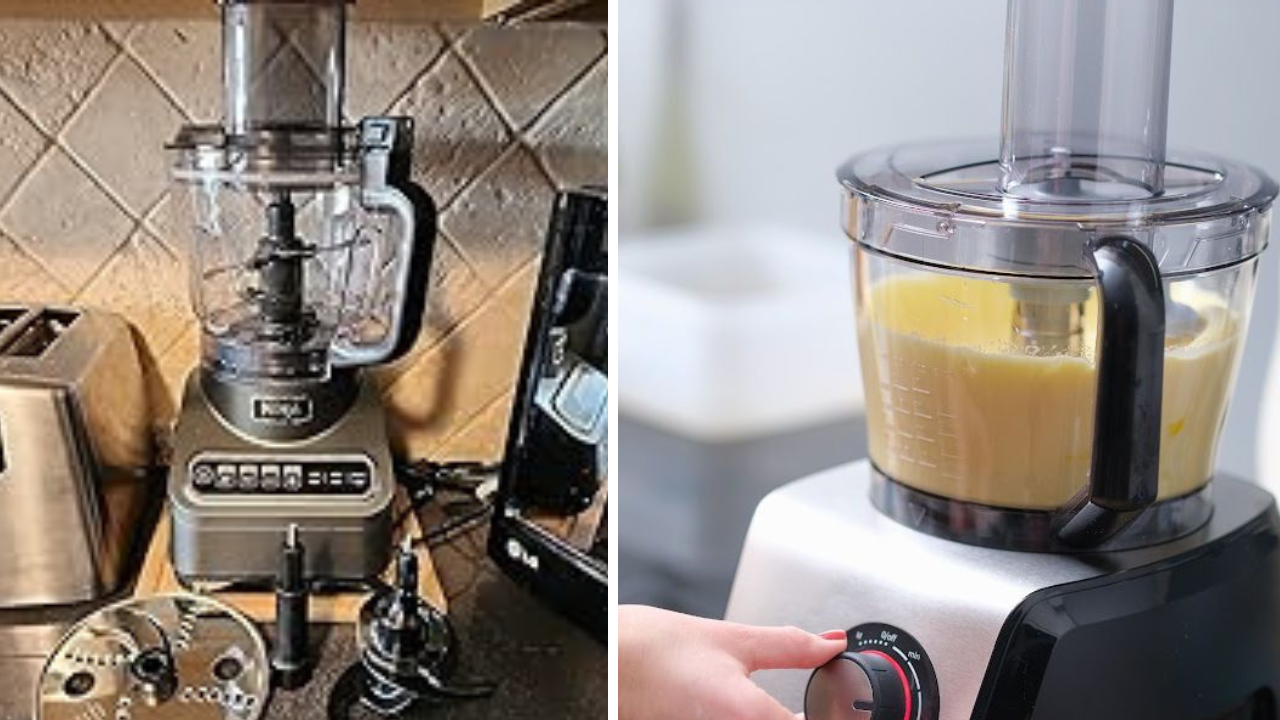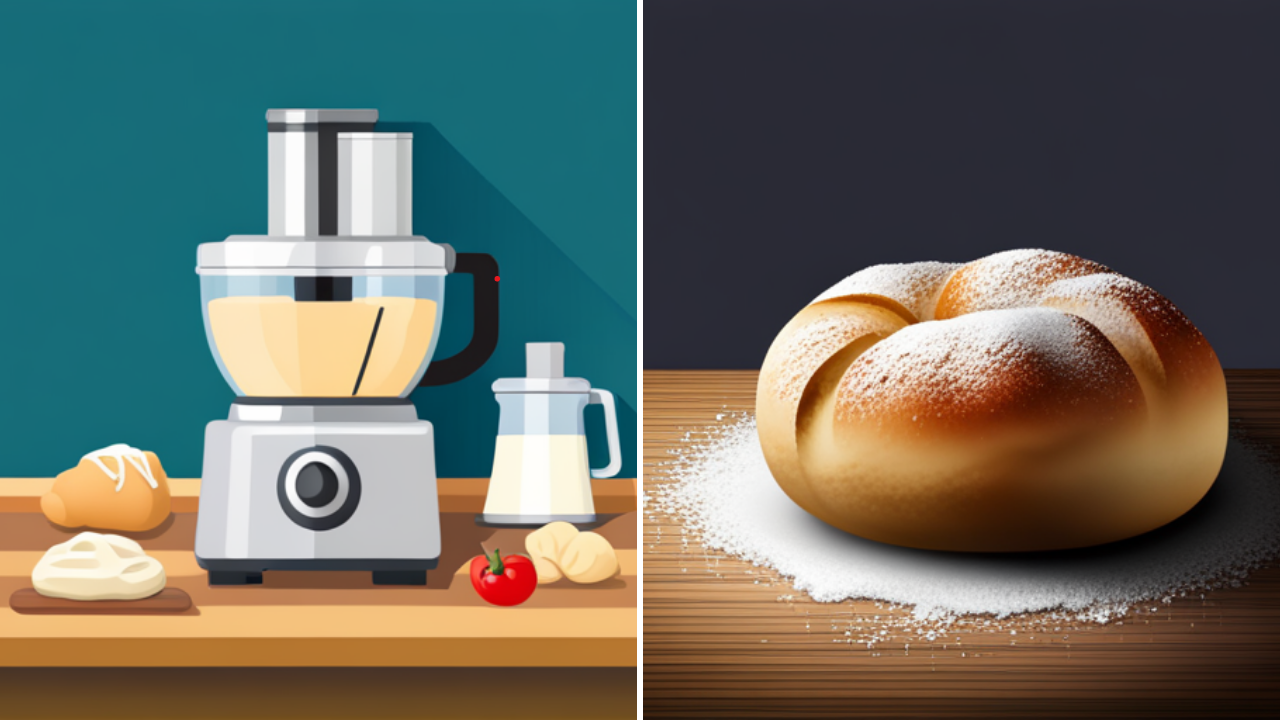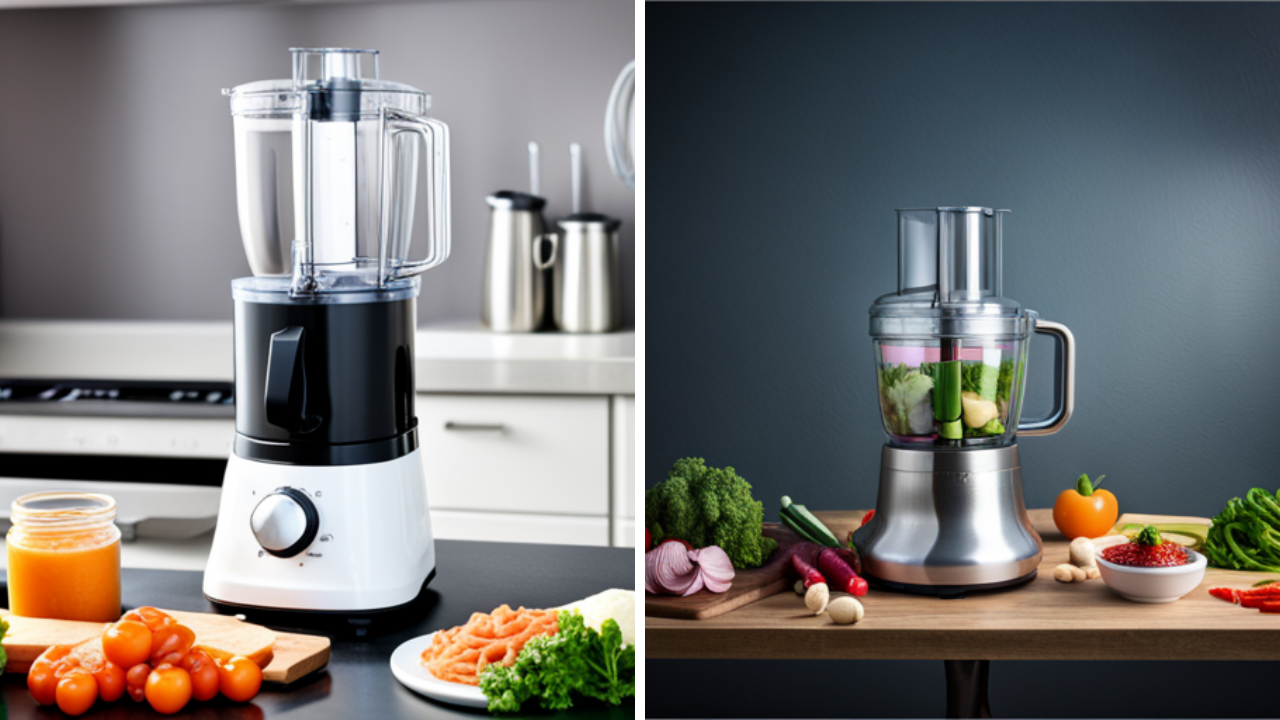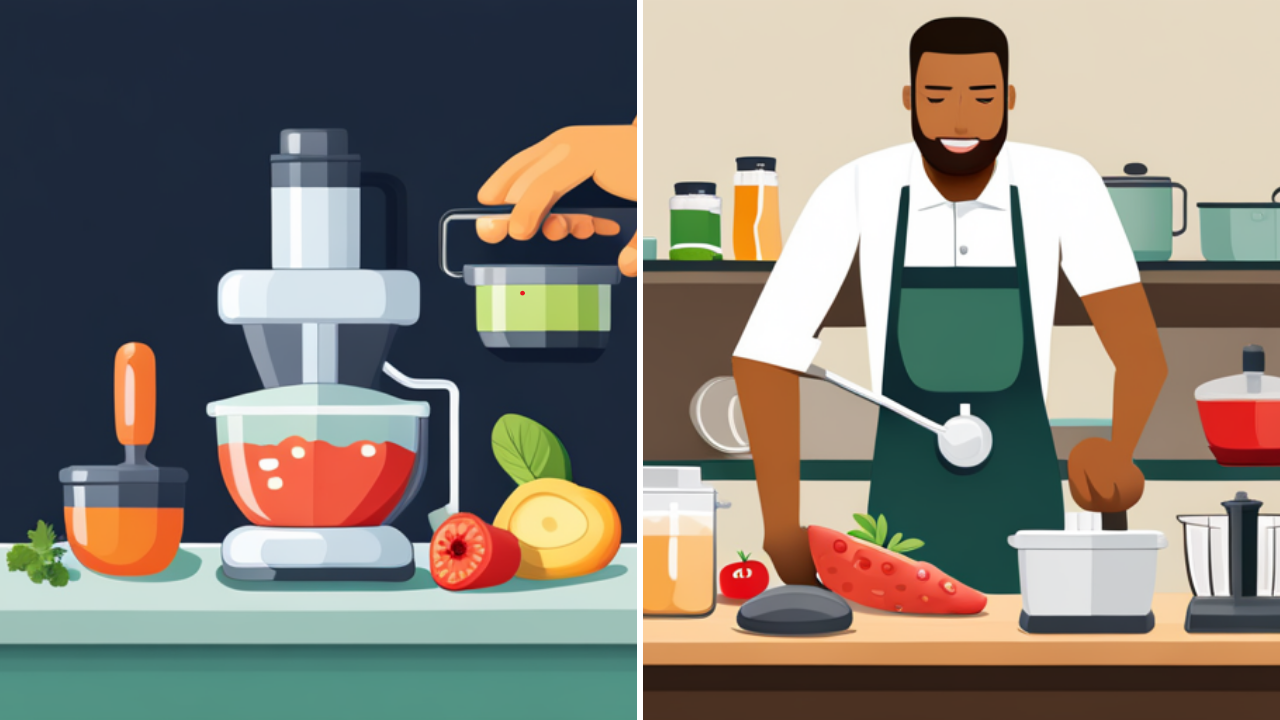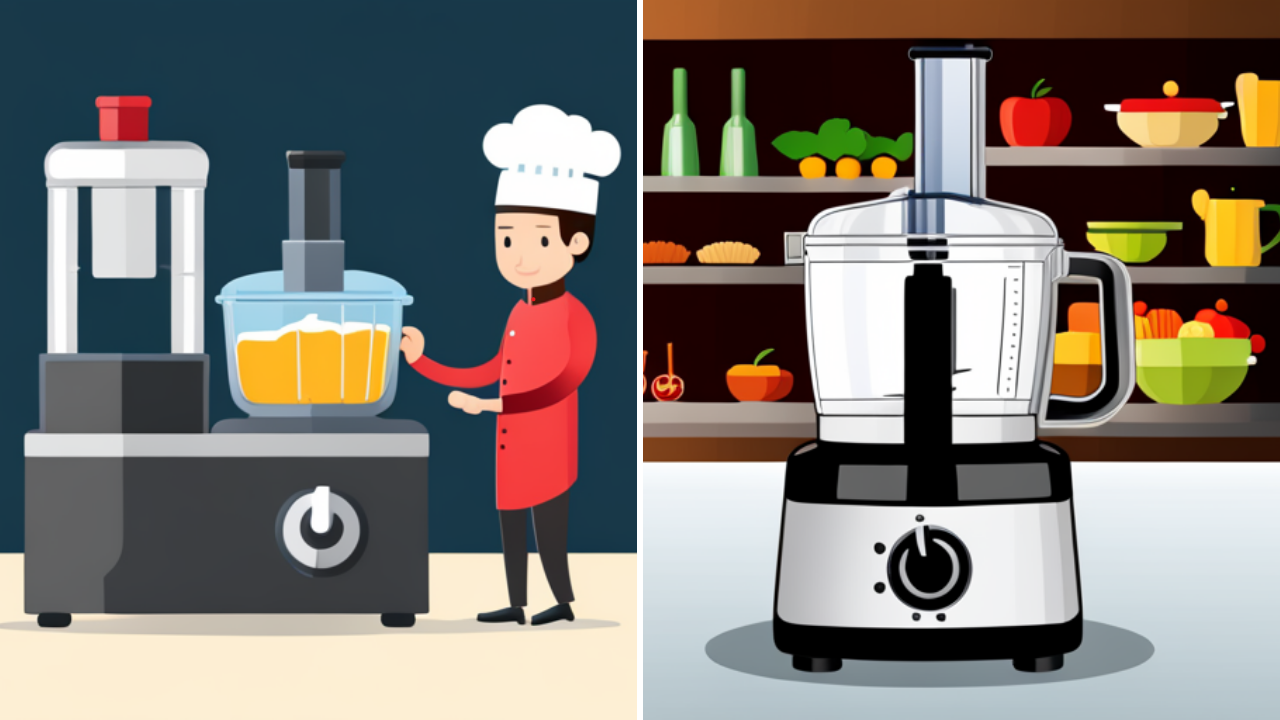Immersion blenders and food processors are two essential kitchen appliances that can help you prepare a variety of dishes.
While they may seem similar at first glance, they have distinct differences that make each of them better suited for particular tasks.
Understanding these differences can help you determine which appliance is best for your cooking needs.
An immersion blender, also known as a hand blender, is a handheld device that features a long, slender shaft with a blade at the end.
It is designed for blending and pureeing ingredients directly in the container, such as soups, smoothies, and sauces. Immersion blenders are compact, easy to use, and require minimal cleanup, making them an excellent choice for everyday cooking.
On the other hand, a food processor is a countertop appliance that features a motorized base and a bowl with a blade attachment.
It is designed for chopping, slicing, shredding, and pureeing ingredients in large quantities, such as vegetables, fruits, nuts, and meat.
Food processors are versatile, powerful, and can handle a wide range of tasks, making them ideal for batch cooking and meal prep.
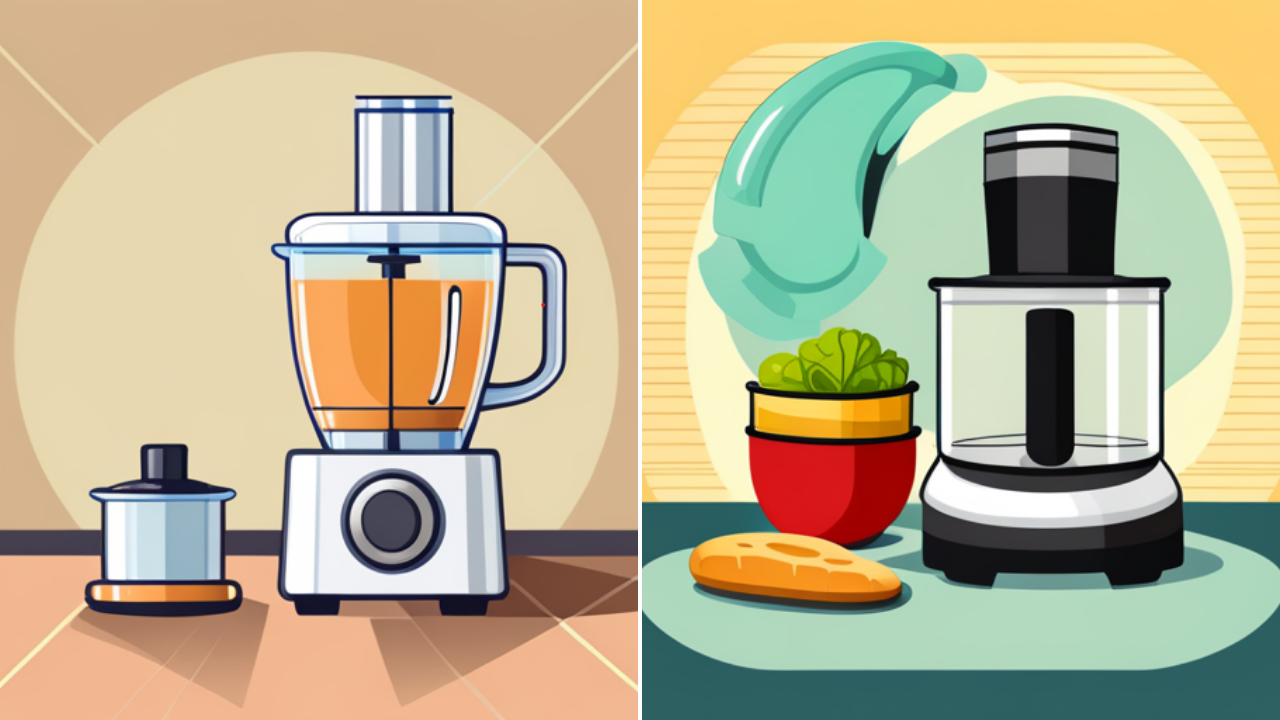
Key Takeaways
- Immersion blenders are handheld devices designed for blending and pureeing ingredients directly in the container, while food processors are countertop appliances designed for chopping, slicing, shredding, and pureeing ingredients in large quantities.
- Immersion blenders are compact, easy to use, and require minimal cleanup, while food processors are versatile, powerful, and can handle a wide range of tasks.
- Choosing between an immersion blender and a food processor depends on the specific task at hand, the quantity of ingredients, and personal preferences.
What is an Immersion Blender?
An immersion blender, also known as a hand blender or stick blender, is a handheld kitchen tool used for blending and pureeing food. It consists of a motorized handle with a long shaft that ends in a blade.
The blade is submerged into the food and the motor is turned on to blend the ingredients together.
Immersion blenders come in a variety of sizes and shapes, but most have a simple design with a few basic components.
The motor is usually located in the handle and is connected to the blade via a long shaft. The blade is typically made of stainless steel and has a variety of shapes and sizes, depending on the intended use.
Some immersion blenders also come with additional attachments, such as a whisk or a chopper, to expand their functionality.
Immersion blenders are often preferred over traditional blenders or food processors because they are more versatile and easier to use. They can be used to blend soups, puree vegetables, make smoothies, and even whip cream.
They are also easier to clean than traditional blenders or food processors since they can be submerged in water and cleaned with soap and water.
Overall, immersion blenders are a useful tool for any home cook or professional chef. They are versatile, easy to use, and easy to clean, making them a convenient addition to any kitchen.
Essential Features of an Immersion Blender
An immersion blender, also known as a hand blender, is a versatile kitchen tool that can be used for various cooking purposes. Here are some of the essential features of an immersion blender:
Portability and Convenience
One of the main advantages of an immersion blender is its portability and convenience.
It is a handheld device that can be easily moved around the kitchen and used in any container, such as a pot, bowl, or pitcher.
Unlike a food processor, which is a bulky machine that requires a large countertop space, an immersion blender can be stored in a drawer or cupboard, making it an ideal choice for small kitchens or those with limited storage space.
Ideal for Liquids
Another essential feature of an immersion blender is its ability to blend liquids. It is perfect for making soups, sauces, smoothies, and other liquid-based recipes.
Unlike a food processor, which may struggle with liquids and require additional liquid to be added to the recipe, an immersion blender can blend liquids smoothly and evenly without any extra liquid.
Ease of Cleaning
Cleaning an immersion blender is also easy and convenient. Most immersion blenders come with detachable blending arms that can be easily removed and washed in the dishwasher or by hand.
Unlike a food processor, which has many parts that need to be disassembled and cleaned separately, an immersion blender can be cleaned in a matter of minutes.
In summary, an immersion blender is a versatile, portable, and convenient kitchen tool that can be used for various cooking purposes.
Its ability to blend liquids smoothly, ease of cleaning, and portability make it an ideal choice for any home cook or professional chef.
What is a Food Processor?
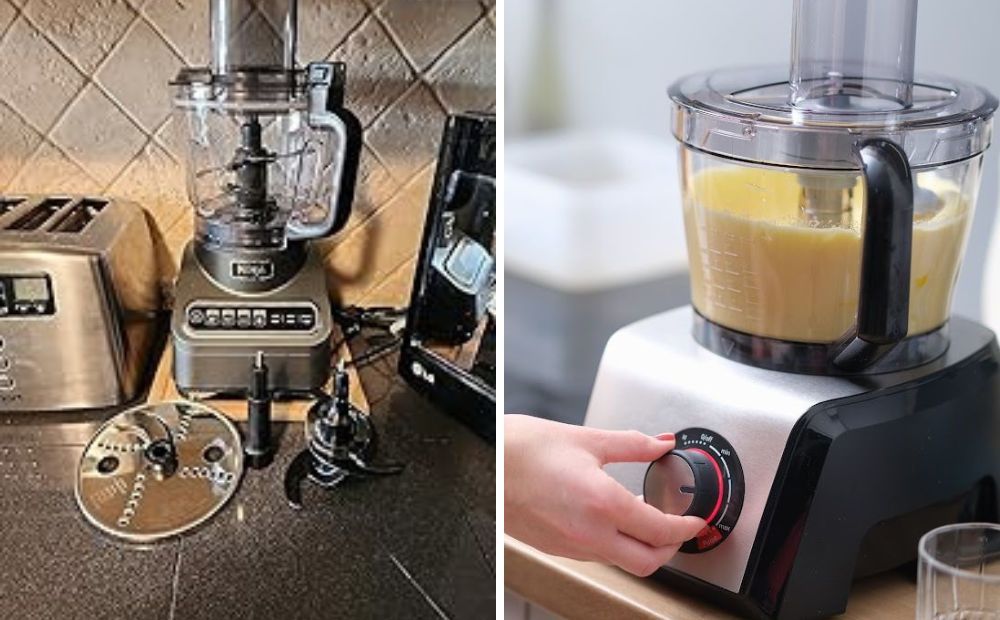
Food processors
A food processor is a kitchen appliance used to chop, slice, grate, puree, and mix food. It is a versatile tool that can handle a variety of tasks, from making dough to shredding cheese.
Food processors are typically larger than immersion blenders and have a motorized base with a bowl and various attachments.
The bowl of a food processor is typically made of plastic or metal and can range in size from 4 to 14 cups. Some models come with multiple bowls, allowing for different sizes to be used for different tasks.
The attachments that come with a food processor can include a blade for chopping and pureeing, a shredding disc for shredding cheese or vegetables, and a slicing disc for slicing fruits and vegetables.
Food processors are great for tasks that require a lot of chopping or mixing, such as making pesto or hummus.
They can also be used to make dough for bread or pizza, as well as for grating cheese or slicing vegetables for salads.
Overall, a food processor is a versatile and useful kitchen tool that can save time and effort in the kitchen.
Key Characteristics of a Food Processor
A food processor is a versatile kitchen appliance that can be used for various food preparation tasks. Here are some of the key characteristics of a food processor:
Versatility
One of the main advantages of a food processor is its versatility. It can be used for a wide range of tasks, such as chopping, slicing, shredding, pureeing, and mixing.
With the right attachments, a food processor can even be used to make dough, grind meat, and juice fruits and vegetables.
Capacity
Food processors come in different sizes, ranging from small models that can hold a few cups of food to large models that can hold up to 14 cups or more.
The capacity of a food processor is an important consideration, as it determines how much food can be processed at once. A larger capacity is useful for preparing meals for a large family or for batch cooking.
Complex Tasks Capability
Food processors are capable of handling complex food preparation tasks that would be difficult or time-consuming to do by hand.
For example, a food processor can quickly and easily chop vegetables, grate cheese, or puree soups and sauces. It can also be used to make nut butter, hummus, and other dips and spreads.
Overall, a food processor is a versatile and useful kitchen appliance that can save time and effort in food preparation. Its key characteristics include versatility, capacity, and the ability to handle complex tasks.
Comparing Immersion Blender and Food Processor
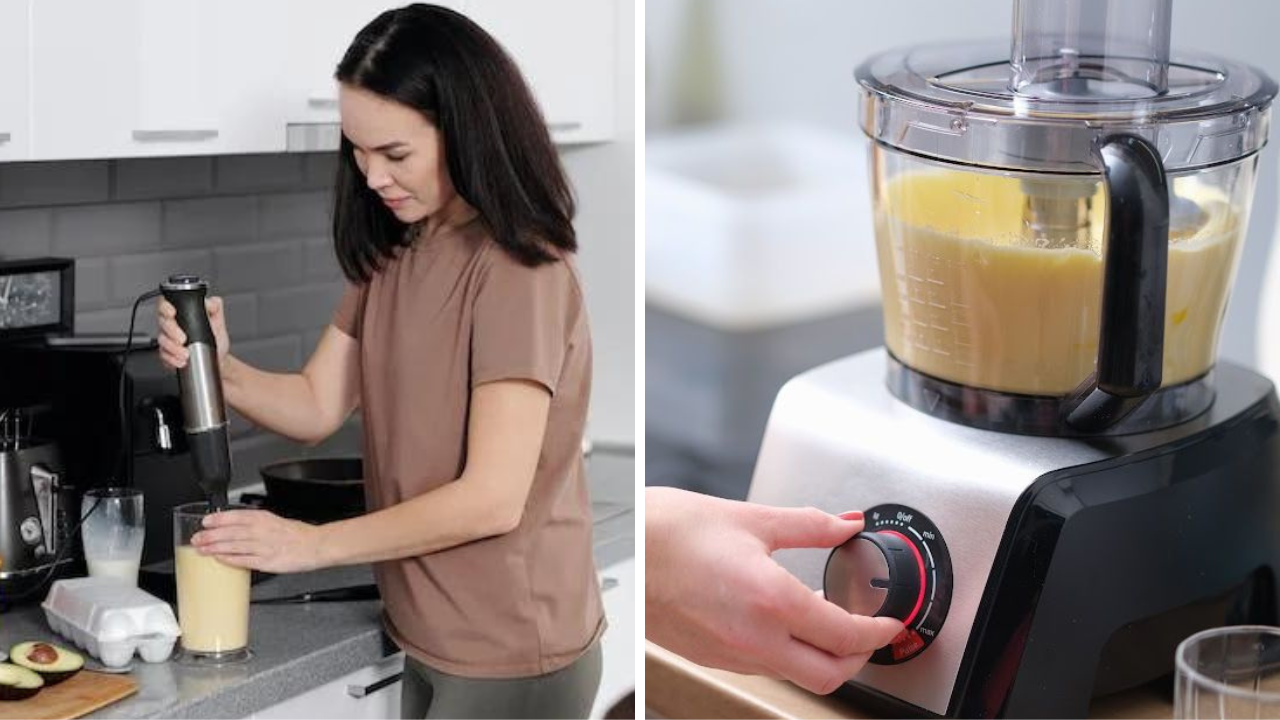
Immersion blender vs food processor
When it comes to kitchen appliances, immersion blenders and food processors are two of the most popular choices.
While both appliances are designed to make food preparation easier, they have different features and functions that make them suitable for different tasks.
Functionality
Immersion blenders are handheld devices that are designed to blend or puree food directly in a pot, bowl, or other container.
They are perfect for making soups, sauces, and smoothies. They are also great for blending small quantities of food quickly and easily.
On the other hand, food processors are countertop appliances that are designed to chop, slice, shred, and puree food. They are perfect for making large quantities of food, such as salsa, hummus, and pesto.
They can also be used to knead dough and grind meat.
Price
When it comes to price, immersion blenders are generally less expensive than food processors. You can find a good quality immersion blender for around $30 to $50, while a good quality food processor can cost anywhere from $100 to $500.
Space Requirement
Immersion blenders are small and compact, which makes them perfect for small kitchens or for people who don't have a lot of storage space. They can easily be stored in a drawer or on a shelf.
Food processors, on the other hand, are larger and take up more counter space. They are best suited for people who have larger kitchens or who do a lot of cooking.
In summary, both immersion blenders and food processors have their own unique features and functions.
Immersion blenders are perfect for blending small quantities of food quickly and easily, while food processors are better suited for making larger quantities of food.
When it comes to price, immersion blenders are generally less expensive than food processors.
And when it comes to space requirement, immersion blenders are small and compact, while food processors are larger and take up more counter space.
Immersion Blender vs Food Processor | Which One's Better For What? - Kitchen Gadget Zone
When to Use Immersion Blender
An immersion blender is a versatile kitchen tool that can be used for a variety of tasks. Here are a few situations where an immersion blender might be the better choice:
- Making soups and sauces: An immersion blender is particularly useful for creating smooth, creamy soups and sauces. It can be used to puree ingredients directly in the pot, eliminating the need to transfer hot liquid to a blender or food processor.
- Mixing drinks: An immersion blender is also great for mixing drinks, such as smoothies, milkshakes, and cocktails. It can quickly blend ingredients together, creating a smooth and consistent texture.
- Emulsifying dressings and sauces: An immersion blender is perfect for creating emulsions, such as salad dressings and mayonnaise. It can quickly blend oil and vinegar together, creating a smooth and creamy texture.
- Pureeing baby food: An immersion blender can be used to puree baby food, creating a smooth and consistent texture that is easy for babies to eat.
Overall, an immersion blender is a great tool to have in the kitchen for tasks that require blending or pureeing small to medium-sized quantities of ingredients.
When to Use Food Processor
A food processor is a versatile kitchen appliance that can be used for a variety of tasks. Here are some instances when a food processor might be the better choice:
- Chopping vegetables: A food processor can quickly chop vegetables into small, uniform pieces. This is especially useful when making soups, stews, or salads.
- Making dough: A food processor can be used to make dough for bread, pizza, and other baked goods. The dough blade attachment can knead the dough quickly and evenly.
- Pureeing: A food processor can puree fruits and vegetables into a smooth consistency. This is useful for making baby food, sauces, and dips.
- Grinding: A food processor can grind nuts, seeds, and spices into a fine powder. This is useful for making homemade spice blends and nut butters.
- Shredding: A food processor can shred cheese, cabbage, and other vegetables quickly and easily. This is useful for making coleslaw, salads, and casseroles.
In general, a food processor is best suited for tasks that require a large capacity and a powerful motor.
It can handle tough ingredients like nuts and vegetables with ease, making it a great choice for many kitchen tasks.
Making the Right Choice
When it comes to choosing between an immersion blender and a food processor, it's important to consider your specific needs and preferences. Here are some factors to consider when making your decision:
Size and Capacity
Immersion blenders are typically smaller and more compact than food processors, making them a great option for those with limited counter or storage space.
However, if you plan on processing large quantities of food at once, a food processor may be a better choice.
Type of Food
Both immersion blenders and food processors can handle a variety of tasks, but they excel at different types of food preparation.
Immersion blenders are great for blending soups, sauces, and smoothies, while food processors are better suited for chopping vegetables, making dough, and shredding cheese.
Ease of Use
Immersion blenders are generally easier to use than food processors, as they require less setup and cleanup. However, food processors often come with a variety of attachments and blades, allowing for more versatility in the kitchen.
Price
Immersion blenders are typically less expensive than food processors, making them a great option for those on a budget.
However, if you plan on using your appliance frequently and for a variety of tasks, investing in a higher-end food processor may be worth the cost.
Ultimately, the choice between an immersion blender and a food processor comes down to your specific needs and preferences.
Consider the factors above and choose the appliance that will best suit your cooking style and habits.
Frequently Asked Questions
What are the advantages of using an immersion blender over a food processor?
An immersion blender is a great tool for blending and pureeing small batches of food quickly and easily. It is also more versatile than a food processor as it can be used for blending soups, sauces, and smoothies directly in the pot or container they are being prepared in. Immersion blenders are also easier to clean than food processors.
What are the advantages of using a food processor over an immersion blender?
A food processor is a more powerful tool that can handle larger batches of food and a wider variety of tasks. It is great for chopping, grating, and slicing vegetables, fruits, and nuts. A food processor can also knead dough, make purees, and grind meat. It is more suitable for tasks that require a coarser texture, such as making salsa or hummus.
What types of food are best suited for immersion blenders?
Immersion blenders are best suited for blending and pureeing small batches of food, such as soups, sauces, and smoothies. They are also great for making whipped cream, mayonnaise, and salad dressings.
What types of food are best suited for food processors?
Food processors are best suited for chopping, grating, and slicing vegetables, fruits, and nuts. They are also great for making purees, grinding meat, and kneading dough.
Can an immersion blender replace a food processor for certain tasks?
While immersion blenders are versatile, they cannot replace a food processor for all tasks. Food processors are more powerful and can handle larger batches of food, making them better suited for tasks that require a coarser texture or larger quantities of food.
Do I need both an immersion blender and a food processor in my kitchen?
It depends on your cooking needs and preferences. If you frequently prepare soups, sauces, and smoothies, an immersion blender may be more useful for you. If you frequently chop, grate, and slice vegetables, fruits, and nuts, a food processor may be more useful. Some people find that having both tools in their kitchen is helpful for different tasks.
In the market for a new blender or food processor? Check out our articles and top picks below:
